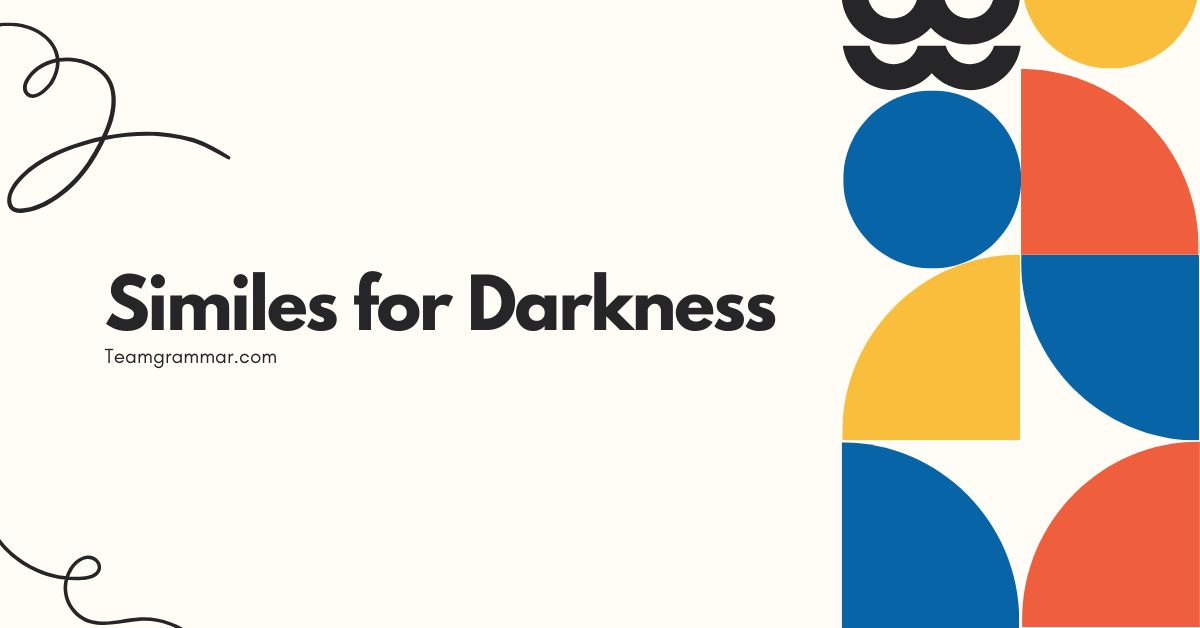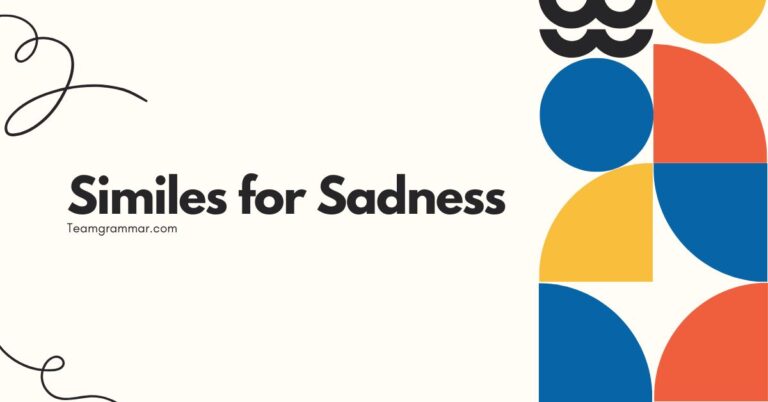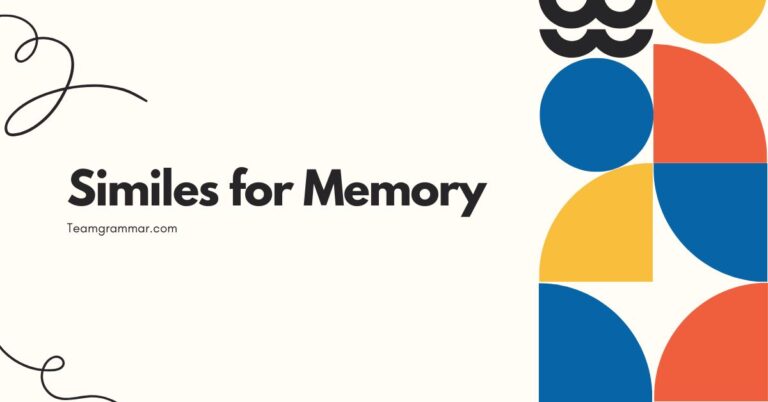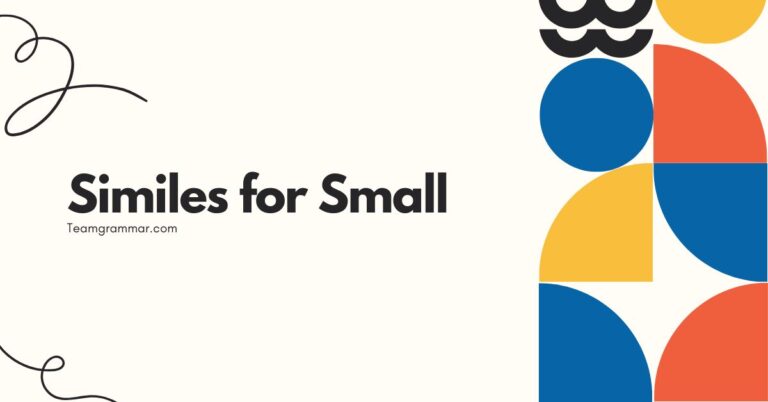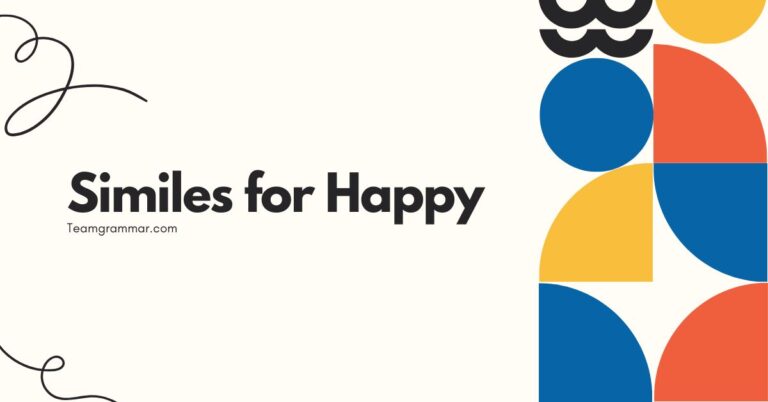43 Similes for Darkness: Mastering Figurative Language
Understanding similes is crucial for enhancing descriptive writing and enriching communication. Similes, a type of figurative language, allow us to draw comparisons between seemingly unrelated things, adding depth and vividness to our expressions.
This article focuses specifically on similes used to describe darkness, exploring their structure, variations, and effective usage. Whether you are a student, writer, or language enthusiast, this comprehensive guide will equip you with the knowledge and tools to master the art of using similes to paint a picture of darkness with words.
Table of Contents
- Introduction
- Definition of Simile
- Structural Breakdown of Similes
- Types of Similes
- Examples of Darkness Similes
- Usage Rules for Similes
- Common Mistakes with Similes
- Practice Exercises
- Advanced Topics in Similes
- Frequently Asked Questions
- Conclusion
Definition of Simile
A simile is a figure of speech that compares two unlike things using the words “like” or “as.” The primary function of a simile is to create a vivid and imaginative description by drawing a parallel between the characteristics of two different entities. In essence, similes enhance understanding and evoke sensory experiences for the reader or listener.
They are classified as a type of figurative language, which deviates from the literal meaning of words to achieve a more impactful effect.
Similes are commonly used in literature, poetry, and everyday conversation to make descriptions more engaging and relatable. By employing similes, writers and speakers can convey complex ideas or emotions in a concise and memorable way.
Understanding the nuances of simile construction and usage is essential for effective communication and creative expression. For example, saying “The night was as black as coal” uses the familiar image of coal to describe the intensity of the darkness.
Structural Breakdown of Similes
The basic structure of a simile consists of three key components: the subject, the connecting word (either “like” or “as”), and the object of comparison. The subject is the entity being described, while the object of comparison is the entity to which the subject is being likened.
The connecting word serves as the bridge between the two, indicating that a comparison is being made.
The formula for a simile can be represented as: Subject + Connecting Word (like/as) + Object of Comparison. For example, in the simile “The darkness was like a heavy blanket,” the subject is “darkness,” the connecting word is “like,” and the object of comparison is “a heavy blanket.” This structure allows for a clear and concise comparison, enabling the reader to visualize the intended image or concept.
Understanding this structural framework is crucial for creating effective and impactful similes. By carefully selecting the subject and object of comparison, and using the appropriate connecting word, writers can craft similes that resonate with their audience and enhance the overall quality of their writing.
Paying attention to the specific qualities being compared can also add depth and nuance to the simile, making it more than just a superficial comparison.
Types of Similes
Similes can be categorized based on the type of comparison they make. Some common types include:
- Descriptive Similes: These similes focus on physical attributes or characteristics. Example: The darkness was as thick as pea soup.
- Emotional Similes: These similes relate the subject to an emotion or feeling. Example: The darkness felt like a heavy weight on my soul.
- Action Similes: These similes compare actions or behaviors. Example: The shadows moved like creeping spiders.
- Abstract Similes: These similes compare abstract concepts or ideas. Example: The mystery was as dark as the unknown.
Each type of simile serves a different purpose and can be used to achieve various effects in writing. Descriptive similes are useful for creating vivid imagery, while emotional similes can evoke strong feelings in the reader.
Action similes add dynamism to descriptions, and abstract similes can help to clarify complex ideas. By understanding the different types of similes, writers can choose the most appropriate type for their specific needs and goals.
Examples of Darkness Similes
Exploring examples of similes related to darkness can provide a deeper understanding of their application and effectiveness. These examples are categorized to illustrate the diverse ways in which darkness can be compared to other entities.
Darkness Like Objects
These similes compare darkness to various objects, emphasizing its physical or tangible qualities. The following table provides numerous examples of darkness being compared to different objects to evoke a sense of its depth, texture, or impenetrability.
| Simile | Explanation |
|---|---|
| The darkness was like a heavy blanket. | Emphasizes the oppressive and enveloping nature of the darkness. |
| The darkness was as thick as pea soup. | Highlights the density and near-impenetrability of the darkness. |
| The darkness was like a black curtain. | Suggests the darkness is a barrier, obscuring everything behind it. |
| The darkness was as deep as a well. | Implies the darkness is profound and seemingly bottomless. |
| The darkness was like a velvet cloth. | Conveys a sense of smooth, soft, and luxurious darkness. |
| The darkness was as solid as a wall. | Indicates the darkness is substantial and unyielding. |
| The darkness was like a bottomless pit. | Suggests the darkness is infinite and inescapable. |
| The darkness was as black as coal. | Highlights the intense, sooty color of the darkness. |
| The darkness was like ink spilled across the sky. | Creates a visual image of darkness spreading and covering everything. |
| The darkness was as heavy as lead. | Emphasizes the oppressive weight and burden of the darkness. |
| The darkness was like a shroud. | Suggests a sense of death, mourning, and concealment. |
| The darkness was as impenetrable as a fortress. | Highlights the inability to see or pass through the darkness. |
| The darkness was like a shadow cast by a giant. | Implies an immense and overwhelming presence of darkness. |
| The darkness was as black as night. | A straightforward comparison emphasizing the characteristic color of night. |
| The darkness was like a void. | Suggests emptiness, absence, and nothingness. |
| The darkness was as complete as a blackout. | Highlights the total absence of light. |
| The darkness was like a cave. | Conveys a sense of enclosure, confinement, and hiddenness. |
| The darkness was as dense as fog. | Implies limited visibility and a sense of disorientation. |
| The darkness was like a tomb. | Suggests death, stillness, and entombment. |
| The darkness was as absolute as space. | Highlights the vastness and all-encompassing nature of the darkness. |
| The darkness was like a closed book. | Suggests hidden stories and secrets. |
| The darkness was as still as a pond. | Emphasizes the lack of movement and activity in the darkness. |
| The darkness was like a locked room. | Conveys a sense of mystery and inaccessibility. |
| The darkness was as silent as a grave. | Highlights the complete absence of sound. |
Darkness Like Animals
These similes compare darkness to animals, often emphasizing its predatory, stealthy, or mysterious qualities. By associating darkness with animals, these similes can evoke a sense of fear, unease, or primal instinct.
| Simile | Explanation |
|---|---|
| The darkness crept like a spider. | Suggests slow, stealthy movement and a sense of unease. |
| The darkness was as silent as an owl. | Highlights the quiet and watchful nature of the darkness. |
| The darkness was like a lurking wolf. | Implies a sense of danger and hidden threat. |
| The darkness was as watchful as a cat. | Conveys a sense of alertness and observation. |
| The darkness was like a swarm of bats. | Suggests a chaotic and overwhelming presence. |
| The darkness was as still as a snake waiting to strike. | Highlights a sense of hidden danger and imminent threat. |
| The darkness was like a black panther. | Implies sleekness, power, and stealth. |
| The darkness was as deep as a whale’s shadow in the ocean. | Conveys a sense of immense depth and mystery. |
| The darkness was like a flock of crows descending. | Suggests an ominous and foreboding atmosphere. |
| The darkness was as relentless as a shark. | Highlights persistence and unyielding nature. |
| The darkness was like a spider’s web, trapping the light. | Implies confinement and the capture of brightness. |
| The darkness was as enveloping as a bear’s hug. | Conveys a sense of being completely surrounded and consumed. |
| The darkness was like a silent predator. | Suggests a hidden and dangerous presence. |
| The darkness was as patient as a vulture. | Highlights a sense of waiting and anticipation. |
| The darkness was like a blackbird’s wing. | Implies a swift and silent descent. |
| The darkness was as murky as a swamp. | Conveys a sense of confusion and hidden dangers. |
| The darkness was like a shadow of a dragon. | Suggests immense power and a mythical presence. |
| The darkness was as all-seeing as an eagle. | Highlights a sense of constant observation. |
| The darkness was like a chameleon, blending into everything. | Implies adaptability and concealment. |
| The darkness was as suffocating as a python’s grip. | Conveys a sense of being trapped and unable to breathe. |
Darkness Like Emotions
These similes compare darkness to emotions, highlighting its psychological impact and the feelings it can evoke. By associating darkness with emotions, these similes can convey a sense of fear, sadness, or mystery.
| Simile | Explanation |
|---|---|
| The darkness felt like a heavy weight on my soul. | Emphasizes the oppressive and burdensome feeling of the darkness. |
| The darkness was as cold as despair. | Highlights the chilling and hopeless nature of the darkness. |
| The darkness was like a blanket of sorrow. | Suggests a pervasive and enveloping sense of sadness. |
| The darkness was as suffocating as fear. | Conveys a sense of being trapped and overwhelmed by anxiety. |
| The darkness felt like loneliness itself. | Implies a profound and isolating sense of solitude. |
| The darkness was as empty as regret. | Highlights the hollowness and sense of loss associated with the darkness. |
| The darkness was like a shroud of depression. | Suggests a pervasive and enveloping sense of sadness and hopelessness. |
| The darkness was as unsettling as anxiety. | Conveys a sense of unease and apprehension. |
| The darkness felt like a nightmare come to life. | Implies a terrifying and surreal experience. |
| The darkness was as consuming as grief. | Highlights the all-encompassing and overwhelming nature of sadness. |
| The darkness was like a cloak of secrecy. | Suggests hidden intentions and concealed truths. |
| The darkness was as disorienting as confusion. | Conveys a sense of being lost and uncertain. |
| The darkness felt like a premonition of doom. | Implies a sense of impending disaster. |
| The darkness was as oppressive as guilt. | Highlights the burdensome and suffocating feeling of remorse. |
| The darkness was like a veil of mystery. | Suggests hidden secrets and unknown possibilities. |
| The darkness was as silent as contemplation. | Conveys a sense of deep thought and introspection. |
| The darkness felt like a ghost from the past. | Implies a haunting and lingering presence. |
| The darkness was as isolating as exile. | Highlights the sense of being cut off and alone. |
| The darkness was like a prison of despair. | Suggests confinement and hopelessness. |
| The darkness was as unforgiving as fate. | Conveys a sense of inevitability and harshness. |
Darkness Like Textures
These similes compare darkness to textures, focusing on its tactile qualities and how it feels. They help to create a more sensory experience of darkness, allowing the reader to imagine how it might feel to the touch.
| Simile | Explanation |
|---|---|
| The darkness was as smooth as silk. | Emphasizes the soft and gentle quality of the darkness. |
| The darkness was like coarse sandpaper. | Highlights the rough and irritating nature of the darkness. |
| The darkness was as velvety as a rose petal. | Conveys a sense of luxurious softness and comfort. |
| The darkness was like cold steel. | Suggests a harsh and unyielding quality. |
| The darkness was as thick as molasses. | Implies a slow-moving and viscous quality. |
| The darkness was like a prickly bush. | Suggests discomfort and irritation. |
| The darkness was as soft as a feather. | Emphasizes the light and gentle quality of the darkness. |
| The darkness was like rough bark. | Highlights the uneven and rugged texture. |
| The darkness was as slick as ice. | Conveys a sense of danger and instability. |
| The darkness was like tangled yarn. | Suggests confusion and complexity. |
| The darkness was as dense as clay. | Implies a heavy and unyielding quality. |
| The darkness was like a net of woven shadows. | Suggests entrapment and complexity. |
| The darkness was as fluid as water. | Emphasizes the flowing and adaptable quality of the darkness. |
| The darkness was like crumbling stone. | Suggests decay and instability. |
| The darkness was as gritty as sand. | Conveys a sense of discomfort and irritation. |
| The darkness was like a padded cell. | Suggests confinement and a lack of stimulation. |
| The darkness was as sticky as tar. | Implies entrapment and difficulty in moving. |
| The darkness was like a web of spun sugar. | Suggests a fragile and deceptive beauty. |
| The darkness was as rigid as petrified wood. | Highlights the unyielding and inflexible quality. |
| The darkness was like a cloud of cotton. | Emphasizes the soft and enveloping quality. |
Darkness Like States
These similes compare darkness to different states of being or conditions, emphasizing its characteristics or effects. This can include states of sleep, death, or other abstract conditions that share qualities with darkness.
| Simile | Explanation |
|---|---|
| The darkness was as deep as sleep. | Emphasizes the profound and enveloping nature of the darkness. |
| The darkness was like a long, silent dream. | Suggests a surreal and introspective experience. |
| The darkness was as still as death. | Highlights the complete absence of movement and life. |
| The darkness was like a forgotten memory. | Implies obscurity and a sense of being lost in time. |
| The darkness was as vast as the unknown. | Conveys a sense of mystery and limitless possibilities. |
| The darkness was like a state of oblivion. | Suggests a complete lack of awareness and consciousness. |
| The darkness was as complete as isolation. | Highlights the sense of being cut off and alone. |
| The darkness was like a moment of perfect silence. | Suggests tranquility and the absence of disturbance. |
| The darkness was as comforting as a lullaby. | Emphasizes the soothing and calming qualities of the darkness. |
| The darkness was like a journey into the void. | Implies a sense of exploration and uncertainty. |
| The darkness was as inescapable as destiny. | Highlights the sense of inevitability and fate. |
| The darkness was like a realm of shadows. | Suggests a mysterious and ethereal world. |
| The darkness was as profound as enlightenment. | Conveys a sense of deep understanding and insight. |
| The darkness was like a canvas of nothingness. | Suggests emptiness and the potential for creation. |
| The darkness was as eternal as time. | Highlights the boundless and unending nature of the darkness. |
| The darkness was like a dance of secrets. | Suggests hidden intentions and veiled truths. |
| The darkness was as consuming as obsession. | Conveys a sense of being completely absorbed. |
| The darkness was like a descent into the abyss. | Implies a dangerous and irreversible journey. |
| The darkness was as transformative as rebirth. | Highlights the potential for change and renewal. |
| The darkness was like a sanctuary of solitude. | Suggests a place of refuge and peace. |
Usage Rules for Similes
When using similes, it is essential to ensure that the comparison is both logical and effective. The two entities being compared should share a common characteristic that is relevant to the description.
Additionally, the simile should enhance the reader’s understanding or evoke a specific emotion. Avoid using clichéd or overused similes, as they can detract from the originality and impact of your writing.
Rule 1: Ensure Relevance: The comparison should be meaningful and relevant to the context. Don’t compare unrelated things just for the sake of using a simile.
Rule 2: Avoid Clichés: Try to avoid overused similes like “as black as night.” Instead, aim for originality and creativity.
Rule 3: Consider the Audience: Think about your audience and choose comparisons that they will understand and appreciate.
Rule 4: Maintain Clarity: The simile should enhance understanding, not confuse the reader. Make sure the comparison is clear and easy to grasp.
By following these guidelines, you can effectively use similes to add depth, vividness, and creativity to your writing. Remember that the goal of a simile is to enhance communication and evoke sensory experiences for the reader.
Common Mistakes with Similes
Several common mistakes can undermine the effectiveness of similes. One frequent error is using comparisons that are illogical or nonsensical.
For example, comparing darkness to something inherently bright would be contradictory and confusing. Another mistake is using similes that are too vague or generic, failing to create a specific and memorable image.
Finally, overuse of similes can also diminish their impact, making the writing feel forced and unnatural.
Incorrect: The darkness was like sunshine. (Illogical comparison)
Correct: The darkness was like a long tunnel.
Incorrect: The darkness was like a thing. (Vague and unhelpful)
Correct: The darkness was like a shroud, enveloping everything in its path.
By being aware of these common pitfalls, writers can avoid making mistakes and ensure that their similes are both effective and impactful.
Practice Exercises
Test your understanding of similes with the following exercises. Fill in the blanks to complete the similes related to darkness.
| Question | Answer |
|---|---|
| 1. The darkness was as ________ as coal. | black |
| 2. The darkness crept like a ________. | spider |
| 3. The darkness felt like a ________ on my soul. | heavy weight |
| 4. The darkness was as thick as ________. | pea soup |
| 5. The darkness was like a ________ across the sky. | ink spill |
| 6. The darkness was as silent as an ________. | owl |
| 7. The darkness was like a ________ of sorrow. | blanket |
| 8. The darkness was as deep as a ________. | well |
| 9. The darkness was like a ________ wolf. | lurking |
| 10. The darkness was as smooth as ________. | silk |
Exercise 2: Create your own similes for darkness.
- The darkness was like ________.
- The darkness was as ________ as ________.
- The darkness felt like ________.
- The darkness moved like ________.
- The darkness sounded like ________.
- The darkness smelled like ________.
- The darkness tasted like ________.
- The darkness was more ________ than ________.
- The darkness was reminiscent of ________.
- The darkness mirrored ________.
Example Answers:
- The darkness was like a closed book, filled with untold stories.
- The darkness was as cold as a winter’s night.
- The darkness felt like a comforting blanket, shielding me from the world.
- The darkness moved like smoke, swirling and unpredictable.
- The darkness sounded like silence, broken only by the rustling of leaves.
- The darkness smelled like damp earth, rich and fertile.
- The darkness tasted like nothingness, an absence of all sensation.
- The darkness was more profound than any ocean’s depths.
- The darkness was reminiscent of a forgotten dream.
- The darkness mirrored my deepest fears.
Advanced Topics in Similes
For advanced learners, exploring the nuances of simile construction and usage can further enhance their writing skills. This includes understanding the use of extended similes, which develop the comparison over several sentences or paragraphs, and exploring the use of metaphorical similes, which blend elements of simile and metaphor to create a more complex and layered comparison.
Analyzing the works of renowned authors who skillfully employ similes can also provide valuable insights into their effective application.
Extended Similes: These similes develop the comparison over multiple sentences, providing a more detailed and nuanced description.
Metaphorical Similes: These similes combine elements of simile and metaphor, creating a more complex and evocative comparison.
By delving into these advanced topics, writers can elevate their use of similes to a higher level, creating more sophisticated and impactful descriptions.
Frequently Asked Questions
- What is the difference between a simile and a metaphor?
A simile compares two things using “like” or “as,” while a metaphor states that one thing *is* another. A simile is an explicit comparison, whereas a metaphor is an implicit one. For example, “The darkness was like a blanket” (simile) vs. “The darkness was a blanket” (metaphor).
- Can a simile be a cliché?
Yes, similes can become clichés if they are overused and lack originality. It’s best to avoid common comparisons and strive for fresh, imaginative expressions. For example, “as black as night” is a common cliché, while “as black as a raven’s wing under a moonless sky” is more original.
- How can I make my similes more effective?
To make your similes more effective, focus on creating vivid and specific comparisons that resonate with your audience. Choose objects or concepts that are familiar and relatable, and ensure that the comparison is logical and meaningful. Avoid vague or generic similes that fail to create a clear image.
- Is it okay to use multiple similes in one paragraph?
While it is possible to use multiple similes in one paragraph, it is important to do so judiciously. Overusing similes can make your writing feel forced and unnatural. Use them sparingly and strategically to enhance specific descriptions or evoke particular emotions.
- How do I choose the right words for my simile?
Choose words that accurately reflect the qualities you want to emphasize in your comparison. Consider the connotations and associations of the words you use, and select those that best convey the intended meaning. Pay attention to the rhythm and sound of the words to create a pleasing and impactful effect.
- Can similes be used in formal writing?
Yes, similes can be used in formal writing, but they should be used sparingly and with careful consideration. In formal contexts, it is important to maintain a tone of objectivity and clarity. Similes should be used to enhance understanding, not to distract from the main point.
- What is an extended simile?
An extended simile is a simile that is developed over several sentences or paragraphs, providing a more detailed and nuanced comparison. This technique allows writers to explore the similarities between two things in greater depth, creating a more vivid and impactful image.
- How do I know if my simile is effective?
A simile is effective if it enhances the reader’s understanding, evokes a specific emotion, or creates a memorable image. Ask yourself if the comparison is clear, logical, and original. Consider seeking feedback from others to gauge their reaction to your simile.
- What role does context play in creating effective similes?
Context is crucial in creating effective similes. The surrounding text and the overall theme of the writing can influence how a simile is interpreted. A simile that works well in one context might be ineffective or even inappropriate in another. Therefore, it’s important to consider the context when crafting and evaluating similes.
- Are there any cultural considerations when using similes?
Yes, cultural background can significantly impact the interpretation and effectiveness of similes. Comparisons that resonate with one culture might be unfamiliar or even offensive to another. Therefore, it’s essential to be mindful of your audience and choose comparisons that are culturally appropriate and sensitive.
Conclusion
Mastering the art of using similes, particularly those related to darkness, can significantly enhance your writing and communication skills. By understanding the structure, types, and usage rules of similes, you can create vivid and impactful descriptions that resonate with your audience.
Remember to avoid clichés, ensure relevance, and consider the context in which you are using your similes.
Practice using similes in your writing and pay attention to how other writers employ them. By continuously refining your skills, you can become more adept at using similes to add depth, creativity, and emotional resonance to your work.
The ability to effectively use similes is a valuable asset for anyone seeking to improve their communication skills and express themselves with greater clarity and impact. Keep experimenting and exploring new ways to compare darkness to other elements, and you’ll find your writing becoming richer and more engaging.

